U.S. playgrounds are boringly safe. New designs add a whiff of danger
- BY NATE BERG 4 MINUTE READ
Playgrounds are moving way beyond the usual, boring, simple swings and slides.
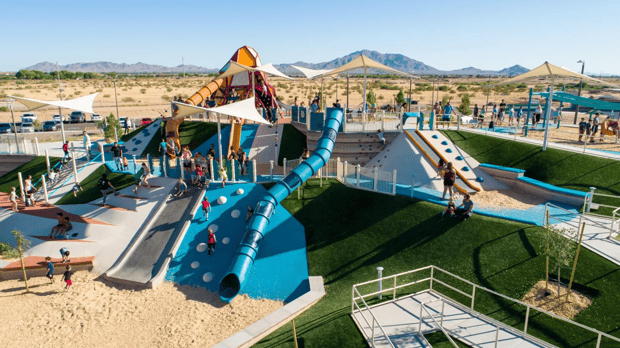
Slides and swings are the bread and butter of the American playground. Whether a tiny neighborhood park or a grand, multimillion-dollar Amazon-size jungle gym, almost any playground in the U.S. is likely to have one or both of these classic standbys. Increasingly, however, those conventional slides and swings are just small pieces of what have become complex and sometimes over-the-top playground spectacles, with themed sculptural mountains of play that climb to unexpected heights.
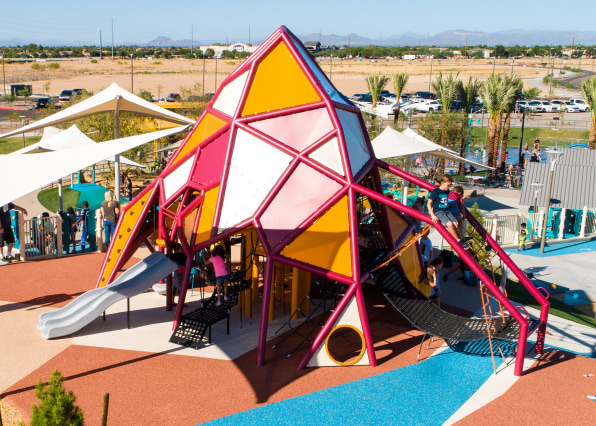
Playgrounds today are becoming more varied, more accessible, and more customized, according to playground experts. Some, surprisingly, may even be getting slightly more dangerous, at least within the limits of U.S. safety standards, giving American children more opportunity to take risks and push limits.
One of the biggest trends reshaping playgrounds and parks across the country, though, is a move toward spaces that reflect the history and diversity of their communities.
“Probably the fastest-growing portion of our business is this whole idea of localized play,” says Scott Roschi, creative director of Landscape Structures, a major designer and supplier of playground equipment. The company works on thousands of playground projects every year, and its swingy, slidey, whirly equipment can be found around the world.
“Yes, we have this catalog of standard play elements, but more and more communities across the country and across the globe are looking for unique, one-of-a-kind, ‘our community has something that no other community has’-type of play experiences,” Roschi says.
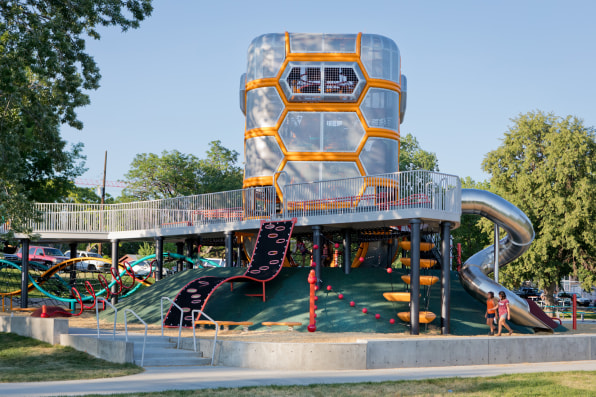
That’s resulting in playgrounds like the one at Denver’s Paco Sanchez Park. Named after the founder of the first Spanish-language radio station in the region, the playground was designed around a theme of sound waves. Part of a $9 million park designed by Denver-based Dig Studio, the playground features ramps and climbing structures that form ribbons of waves throughout, and its centerpiece is a play structure encased in a three-story tower modeled after a 1950s radio microphone. “When the kids are all playing inside it actually emits sound,” Roschi says.
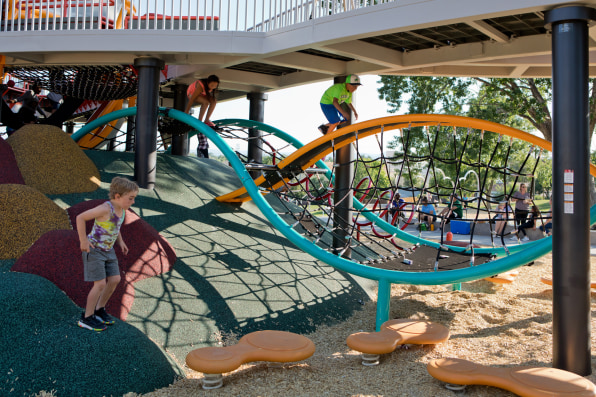
Another set of locally inspired playgrounds is in downtown Omaha, Nebraska, at Gene Leahy Mall at the RiverFront, where the play structures and landscapes embrace the city’s early history as a major stopover in the Lewis and Clark expedition. Designed by OJB Landscape (headed by James Burnett) and Studio Ludo, the playgrounds include arched elements and decks that resemble abstract boats and canoes, and the natural edges of the Missouri River.
Playgrounds like these are also getting taller, with at least a hint of danger. Roschi says Landscape Structures is increasingly asked to design towers and climbable structures rising to heights that would make previous generations of park designers with their 10-foot-tall slides nervous.
U.S. playgrounds tend to be tame compared to those in Europe, where the equipment is less constrained and play can be more adventurous. It’s not uncommon, for instance, to see tall, climbable structures without the kinds of bannisters and barriers incorporated into U.S. designs to prevent injuries by inhibiting falls.
But Roschi says more communities in the U.S. are requesting playground structures that give kids an increased sense of that risk.
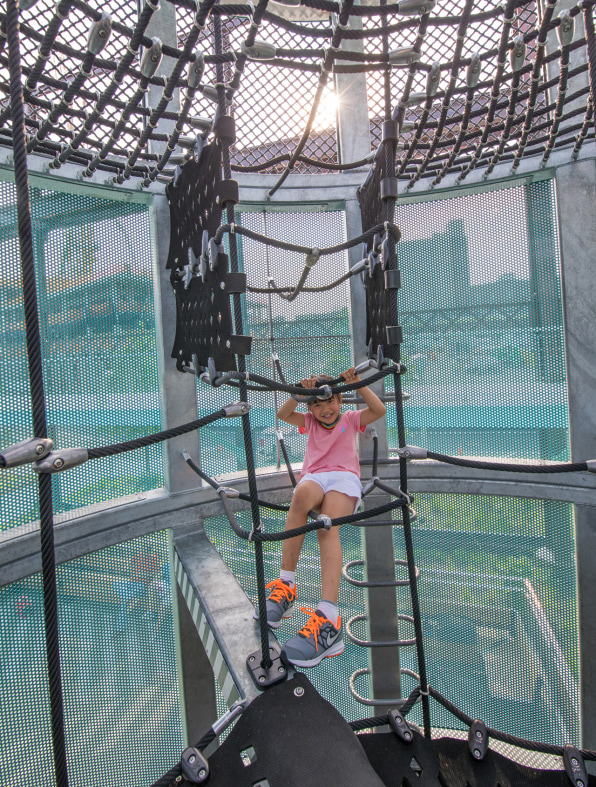
“Especially in this country, it was always a scary thing to get kids up really high,” Roschi says. “But the request from communities across the country [now] is ‘How can we get kids 30-plus feet in the air, do it safely, but create a greater challenge for them?’”
Research shows that children have a natural inclination toward risky play, which can help their development and engender a better capacity for managing risk in other parts of their lives. Including features that allow this risk-taking is increasingly seen as part of the work of playground designers.
“We’re designing spaces and these towers where we can create more of that sense of danger. We prefer the term perceived danger because we’re getting kids up to these super high heights, but they can’t fall more than a few feet,” Roschi says.
Another big trend is accessibility, with more play parks being designed to accommodate, sometimes seamlessly, users with varying physical mobility and sensory sensitivity. “That’s a huge boom right now compared to the last five or ten years,” says Lamar Lee, playground safety manager at the National Recreation and Park Association.
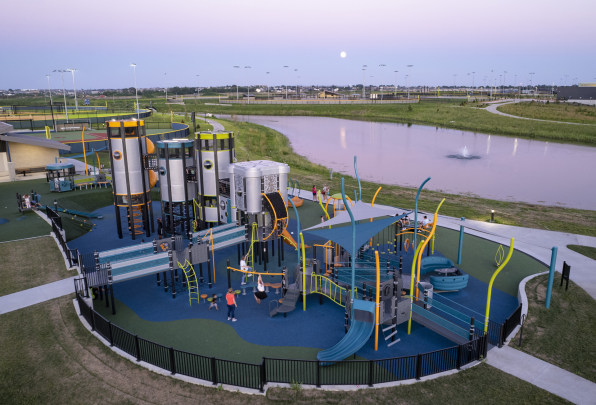
Playgrounds like the one in Triumph Park, in Waukee, Iowa, are being designed not just to include a slide or swing that is wheelchair accessible, but with the entire layout being accessible to people with disabilities or mobility challenges. The structures also include tactile play elements designed to be used by children.

“Every single playground will have something like that in the future, in my estimation,” Lee says.
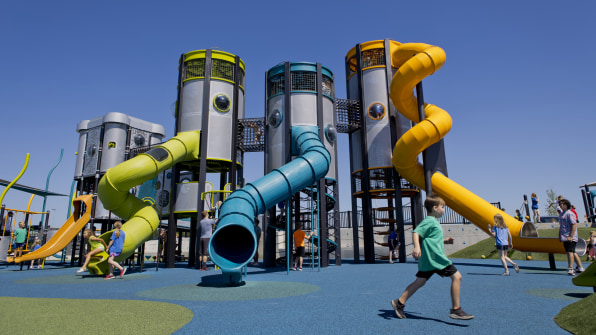
Roschi says these spaces are being reimagined by the changing demands from communities, and a broader sense of who playgrounds are for, opening up new potential for the ways they are used. “We’re creating more non-prescribed play,” he says. “It’s really breaking away the structure so that kids are able to create their own journeys versus designers telling them, ‘This is how you play on this site.’”
